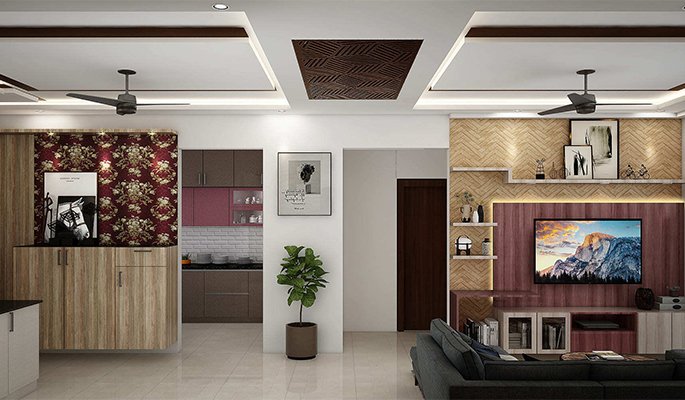

Ceilings are no longer just a roof over your head. Decoration has made its way up to the ceiling to create a living room that is beautiful to look at from every angle. We will show you false ceiling design ideas that will transform the look of your living space.
Your home is a reflection of your personality. The aesthetics and decoration reflect your style. Everything from the walls to the paint colors to the ceiling must be coordinated to be an extension of your personality. If you take care of all aspects of decoration but neglect the decoration of the ceiling, the room will look oddly disjointed, unfinished and chaotic. False ceilings are often an afterthought, either never noticed or added to the room in a way that is not in harmony with the decoration. Their selection and installation must be carefully considered to make the most of the aesthetics and decoration of your home.
A clever false ceiling design in the living room can do many things. It can help save energy and reduce waste. It can even improve and amplify the sound of a room. False ceilings minimize the need for air conditioning, give rooms a different look and much more. The trick to designing them right is good planning and a keen sense of aesthetics.
False ceilings are the upper interior wall of any room, which one would assume remains hidden from many. But you might be wrong because the coziness and warmth of a room depends as much on the upper wall as the four walls that surround it. Most rooms in houses have simple concrete ceilings, but these days many are experimenting with false ceilings. The complexity of such false ceilings for living room designs can vary. Modern interiors work well with geometric lines and curves while traditional homes work with moldings and pillars.

Although ceiling designs require just as much structural planning and architectural input, it helps to know the intricacies and details so that you get something you really want and that will adorn your home for years to come.
The space of the room you are building the false ceiling for should also be considered to ensure that you do not go wrong with the proportions and dimensions. Understand the proportions and adjust the design accordingly. The design of rooms varies from one room to another. What works in the living room may not work in the bedroom and so on. In most cases, living rooms, dining rooms and bedrooms require complex ceiling design as they are either a place for family gatherings or relaxation. Living rooms may need more niches and varied lighting, unlike bedrooms where the requirements are limited. It is wise to consider the type of room and its specific requirements before designing a room.
Simple false ceiling designs for living rooms cannot be the same as other rooms. You need to decide the style before planning the ceiling design. The height is important when it comes to where it is fixed. In living rooms, for example, suspended, wavy ceilings with recessed lights add drama. Textures and contours look beautiful in this room. In bedrooms, false ceilings cannot be too low or complicated otherwise it can even make the room stressful. Also, check if you want the area to be covered, recessed or exposed and plan the design accordingly.

Layered lighting works wonders for a varied effect. Modern ceiling designs for living rooms and their lighting is crucial when you are opting for false ceilings and their contour. Decide in advance how you want to position your ceiling lights. You can choose three different types of lighting and arrange them according to the use of the room. Or you can also design your false ceiling design first and then place the lights. Whatever you do, lighting is a crucial part of false ceilings and can make or break their look. They diffuse and disperse the light which improves overall energy efficiency. For lighting a small area, especially in false ceiling designs for living rooms, a mix of spot lights and cove lighting works just as well.
Ceilings are different in different housesch. While some are high, others are low. This can even vary from room to room. Low ceilings cannot be fixed with false ceilings but can be painted or fitted with some structural elements. High ceilings with wooden ceiling design for living spaces offer more scope for experimentation and design.
The color of the false ceiling in the living room, including the walls, affects the look of the house. Dark wood false ceilings add a majestic effect. Interiors can be brightened, textured and layered with the right ceiling color, and it doesn’t necessarily have to be white. Dark colors make large spaces appear cozier, while light colors suit small spaces best. The finish is also important, as is the way the color blends with the lighting and structure of the room. Whether matte or glossy, experiment with color and sheen to create a space that goes well with the interiors.

One of the least considered aspects of ceiling design is acoustics. Living room ceilings must be designed to absorb sound and noise. Since conversation and music are important, especially in rooms like the living room, acoustics must be considered to enhance sound or distribute it evenly. For rooms with high ceilings, surround sound works well by paneling the ceiling and adjusting the sound inputs.
Textured ceilings for living rooms provide interesting focal points. Ceilings can be made central elements of rooms and focal points by adding various architectural elements such as beadwork, planks, artwork and artificial finishes. They enhance the look and serve as a reference point around which living room interiors can be designed.
Electricity and other utilities are easily accessible. False ceilings often need to be fitted with air conditioning pipes, sprinklers and smoke detectors. The constant work involved can cause damage if alternative arrangements have not been considered. Plan your false ceiling design in such a way that maintenance or repair work is not hampered.
Skylights are an interesting interior design element for living rooms. They can be made in any shape, placed at strategic points and let in plenty of natural light, avoiding the use of artificial light. Add a skylight over a body of water, in the middle of the room or even over the stairs. There is a lot to experiment and learn from. Skylights can be structured, located on multiple levels and attached with frosted or plain glass. They add a different dimension to living rooms.
Ceilings can be designed with different shapes and elements. Generally, rectangular ceilings are the most popular but round shapes work just as well. Curves and circles add a softness and flow to the overall look that is suitable for traditionally designed homes. Geometric designs suit modern or minimalist homes. Decide this based on your budget and other factors.
False ceilings can be designed with a whole range of materials from gypsum to wood to plaster. Gypsum is used in a variety of roofing applications in both residential and commercial settings. It is maintenance-free, can be molded into various designs and is very durable. Gypsum boards, on the other hand, provide thermal and sound insulation, are lightweight and offer good acoustics. Wood panels have structure and are easy to install but can be expensive and require extra maintenance. Fiber and glass are rarely used but are sturdy, fire resistant and look good. Other materials such as fabric, metal and PVC are new and are slowly gaining ground in the design and use of false ceilings.
False ceilings cannot be added after the fact. Their choice and appearance will affect the design and interior design of your entire home. A good choice is inevitable, especially if you want to have a ceiling that will lighten and brighten your room. Some careful thought, a lot of imagination and sensible decisions can help you achieve this.
DailyBlogsHub delivers fresh and engaging content and reviews on a wide range of topics, including fashion, lifestyle, technology, health, business, travel, and more. We offers our readers valuable insights, trends, and expert advice to stay informed and inspired.
© 2025. All Rights Reserved. DAILY BLOGS HUB